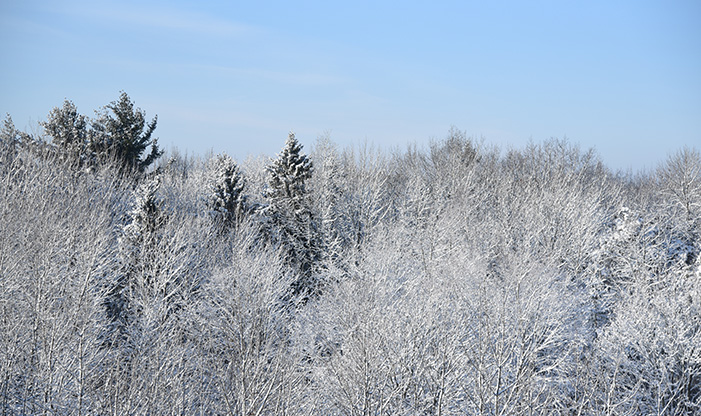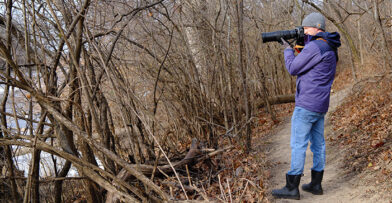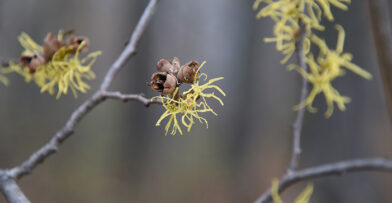Winter is a challenging time for many species of wildlife, including trees. Fortunately, trees have many adaptations that protect them from the effects of freezing weather. Deciduous trees, which are characterized by wide, thin leaves, have a set of behaviors that set them apart from evergreens, which have thicker, often needle-like leaves. Both have adaptations to survive the extreme cold, emerging vibrant when the surrounding temperature becomes warm again in spring.
Deciduous Trees in Cold Weather
Deciduous trees, such as maple, birch, oak, and others, possess leaves that photosynthesize in response to abundant light. Light exists as an electromagnetic spectrum, with visible light appearing in the blue to red colors. Red light, which has a higher frequency than blue light, causes the leaves to photosynthesize. When the season changes in autumn, light quality changes and is characterized by the presence of more, far-red spectrum light, which is similar to shade.
This far-red light stops photosynthesis. Sugar production halts, and the sugars flow out of the leaves. The hormone auxin, which causes growth, declines and abscisic acid is produced. When abscisic acid is present, the deciduous leaf begins to form a layer of cells that will separate the leaf from the stem, like a scab. Ethylene is produced, which disconnects the leaf from the tree.
This entire process causes the brilliant fall spectacle of leaf colors appearing red, yellow, and orange, before falling. Oak and beech tree leaves go through the same color change, but the leaves remain on the tree until they are pushed off by new growth in the spring. This is called marcescence, the exact reasons for which are unknown. Theories suggest marcescence could protect winter buds from desiccation, provide nutrients to the soil in spring when they fall, and deter herbivores from eating the twigs.
The Behavior of Evergreen Trees
Evergreens adapt differently to cold weather than deciduous trees, most notably by continuing to photosynthesize during the winter months. Evergreen leaves remain on the tree, with their thin needle-like structures able to tolerate freezing temperatures. The needles’ dark green color helps the leaf absorb heat from the sun. They also have a waxy coating which insulates the leaf and helps to maintain a warmer temperature inside, and their smaller size makes them more resilient and less breakable. These traits are important for maintaining water flow within the tree. Evergreens grow more slowly in the winter as photosynthesis slows down, but growth rings still appear in the tree trunk.
A category of trees called broadleaf evergreens possess a wider leaf and look like a deciduous tree but behave more like an evergreen. Boxwood, American holly, and rhododendrons are broadleaf evergreens, with dark green leaves that continue to photosynthesize in winter. Red osier dogwood is another exception among trees, photosynthesizing all year within its bark using red and orange pigments, which are called anthocyanins and carotenoids.
The Importance of Heat and Insulation
There are several types of insulation that trees use to adapt to cold weather. One of the important functions of tree insulation is to prevent the cells and tissues from freezing in the trunk and branches.
Water needs to flow throughout the tree in all seasons, but in winter, the tree’s water could freeze. To prevent this, cells create an “anti-freeze” to keep it flowing. When deciduous trees stop photosynthesizing, sugar moves downward into the roots, but not all of it. A mixture of salt and sugar moves out of the cells into tissues, and a part of the mixture that remains in the cells is concentrated, preventing freezing by lowering the freezing point. If the cells freeze, they can explode, damaging tissues and creating an exposure threat.
Trees in which the cells have exploded often split vertically up the bark, disfiguring the tree and potentially allowing bacteria and insects to get inside, which causes disease. Exploding cells damage the xylem and phloem, tissues which reside in the tree trunk and branches and are responsible for keeping the fluids in the tree flowing.
Deciduous trees native to northern climates have thicker bark than their southern equivalents, insulating the trunk and branches. Some species of trees, both deciduous and evergreen, also have bark that is darker, which helps the tree absorb heat, maintaining an acceptable temperature within the tree and preventing freezing and cracking.
Chill Requirements
Another adaptive process in winter is referred to as a “chilling requirement.” Tree species have a varying number of degree days, which is the number of days a tree needs to experience temperatures below 32 degrees to maintain proper timing for budding. Once a tree species experiences its chill requirement, buds will break or start growing when the temperature reaches above freezing.
Northern trees have a longer chill requirement, so buds will not break too early if there are days above 32 degrees. Southern trees have a shorter chill requirement to prevent budding when it is above 32 degrees, so will bud more quickly when temperatures rise. This is critical in Wisconsin, as we often experience numerous thaw days above 32 degrees in January. Because of the chill requirement, this doesn’t cause trees to prematurely bud.
Adaptations of Root Systems
Roots continue to grow until the ground freezes, and those that are beneath the frost line do so throughout the season. When sugar exits deciduous tree leaves in the fall, it flows downward into the roots, which is what makes growth possible. The roots hold sugars until they are released in the spring and move back upward on their way back to the budding leaves. This process is what makes maple sugaring possible, as the sap can be tapped as it flows within the tree’s trunk and its tissues. It is important that harvesters tap the sugar maple trees sustainably, so they will continue to grow and be healthy.
A Tree’s Appearance in Winter
During winter, the buds of deciduous trees, which formerly held stems and leaves in the warmer months, become dehydrated. A hard shell forms around the outside of the bud to protect it. Buds for both flowers and branches become more visible and ornamental in the wintertime. This can be a great aid in identifying trees, making the season a perfect time for exploration.
There are several species with ornate buds that are visible at the Center. Nannyberry, found throughout the property, has long, pointed and slightly curved buds that resemble old German helmets. Shagbark hickory, in part identified by its large buds, can be observed at the end of the walkway near the Visitor Center.
Serviceberry, seen in the Pavilion Courtyard Gardens, have sleek and pointy terminal flower buds. Both buds and leaves on serviceberry are positioned in an alternate pattern. Highbush cranberry, part of the viburnum family, has a terminal bud with a flower cluster. Willow buds are shiny and smooth, and have scales that fall off when the leaves sprout.
Bark is also distinctive and can be another way to identify trees. Shagbark hickory gets its name from its shaggy bark, serviceberry is silvery-gray, and the bark of beech trees is smooth and gray.
Trees are incredible organisms that have adapted over millenia to survive the harshest conditions. For those who would like to dive deeper into tree identification, we are offering a two-part Winter Tree ID program in February. More details are available on our website.
Winter at the Center is a wonderful time to explore the intricacies of trees and be delighted by details of nature!


